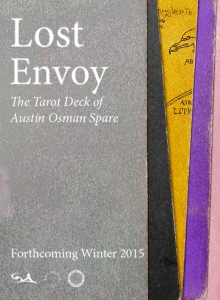From Strange Attractor Press, whose imprint includes Phil Baker’s excellent biography Austin Osman Spare, comes this announcement of an interesting new publication concerning the celebrated British artist and magician:
In the Spring of 2013 a 78-card, hand-painted tarot deck created c.1906 by the mystic and artist Austin Osman Spare, was identified within the collections of The Magic Circle Museum in London.
Austin Spare’s life-long interest in cartomancy is well documented, yet very few of his own fortune-telling cards were thought to have survived. This compelling new example of the artist’s early work demonstrates his precocious involvement with the currents that shaped the British Occult Revival at the beginning of 20th century, and his interactions with some of the period’s lesser-known protagonists.
Magic Circle Museum curator and artist Jonathan Allen immediately recognised that Spare’s cards were not only art-historically significant, but also entirely unknown outside of The Magic Circle’s collections, and set about tracing the deck’s provenance, its place in the artist’s oeuvre and within the wider histories of cartomancy.
Lost Envoy reproduces Austin Spare’s tarot deck in its entirety for the first time, alongside new written and visual contributions from Jonathan Allen, Phil Baker, Helen Farley, Alan Moore, Kevin O’Neill, Sally O’Reilly and Gavin Semple.
Published by Strange Attractor Press in association with The Magic Circle, and supported by Arts Council England. Designed by Frazer Muggeridge Studios, London.
Expected publication date: Winter 2015.
Why This Is Exciting: Estimated to have been painted around 1906–i.e. when the artist was just twenty years old–this deck coincides with Spare holding his earliest exhibitions (Bruton Galleries, 1907) and publishing his first books, Earth Inferno (1905) and A Book of Satyrs (1907). These Tarot cards predate, however, the more fully-realized ideas expressed in The Book of Pleasure (1913), The Focus of Life (1921) and Anathema of Zos (1927). They also predate Austin Spare’s involvement in A.’.A.’. and his contributions to the first issue of Crowley’s Equinox (spring 1909). As such, this publication could provide valuable new insights into the young artist’s direction and interests prior to the moments of his adult career for which he is best known.


